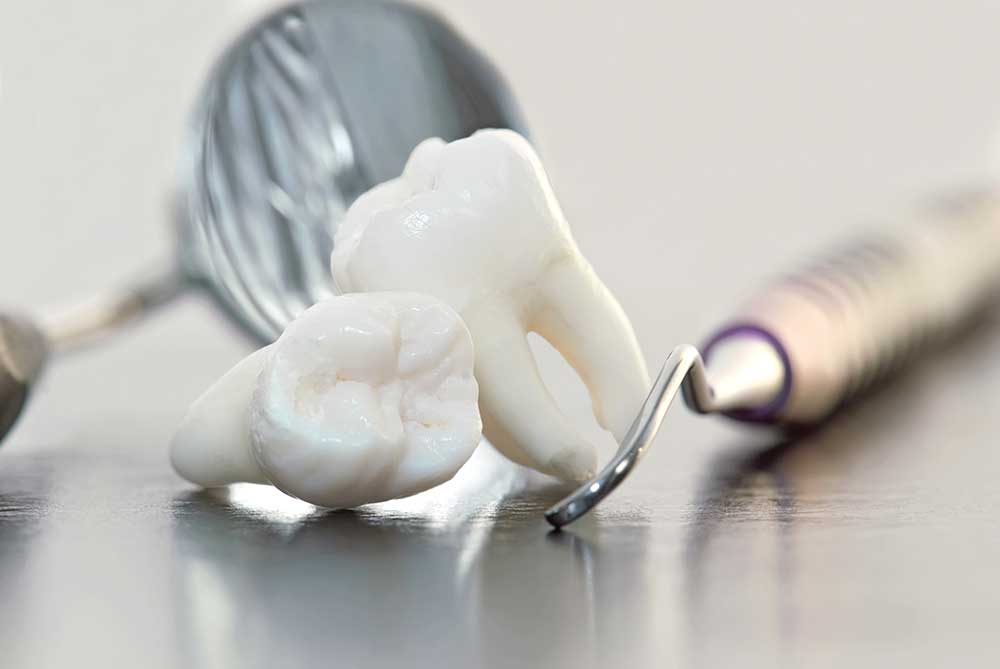Wisdom teeth

Wisdom teeth ?
Wisdom teeth are the third molars.
They normally grow in between the ages of 15 and 25. There are usually four of them (two at the top, two at the bottom), but it is not uncommon for there to be only three, two or none.
Wisdom teeth can be :
- fully erupted; they are then said to be on the arch.
- partially erupted; they are then said to be impacted.
- completely in the bone; either in the germ state (usually before the age of 18) or fully erupted, in which case they are said to be impacted.
Why do we operate?
Votre chirurgien maxillo-facial peut vous proposer l’extraction des dents de sagesse pour différentes raisons :
- Parce qu’elles sont à l’origine de douleurs et/ou de surinfections souvent récidivantes (péri-coronarites). C’est souvent le cas des dents de sagesse incluses ou enclavées.
- Ce peut être aussi le cas de dents de sagesse totalement sorties (sur arcade) maisqui sont cariées et pour lesquelles votre dentiste ne peut plus proposer de soins conservateurs.
- Après un traitement orthodontique, parce que n’ayant pas suffisamment de place pour sortir normalement elles risqueraient alors de venir appuyer sur les autres dents perturbant le bon alignement dentaire et faisant perdre ainsi tout ou partie du bénéfice du traitement orthodontique.

-or under local anaesthetic. The operation is then carried out at the surgery, in one or two sessions spaced out over a reasonable period of time (usually 3 weeks). You are not hospitalised. One side (one upper and one lower wisdom tooth) is operated on first, and the other side is operated on during the second session.
-The operation is performed under general anaesthesia or sedation. The hospitalization is most often ambulatory (entry in the morning and exit in the afternoon); a consultation with the anaesthetist is then mandatory. The anaesthetist will answer your questions about anaesthesia.
Whatever the mode of anaesthesia, the surgical technique remains the same and consists in :
-Incise the gum when necessary (impacted or impacted teeth) to expose the surgical area.
-Freeing the tooth by cutting the surrounding bone to allow it to be sectioned to facilitate its extraction. This is often the case for lower wisdom teeth, more rarely for upper ones.
-Clean the tooth socket (the hole that remains after the tooth has been removed). This socket fills up with a blood clot that will gradually ossify and be completely consolidated about 2 months after the operation.
-The gum is sutured with absorbable sutures which will disappear spontaneously in 10 days to 3 weeks. Sometimes the surgeon does not suture the gum of the upper wisdom tooth because this suture is often unnecessary.
The duration of the operation varies according to the technical difficulties. On average it takes between 5 and 10 minutes per tooth to be extracted.
-Mouthwash, to be started only the day after the operation.
-Pain medication (analgesics).
-Often anti-inflammatory drugs.
-Antibiotics.
-Ice on the cheeks for the first 24 hours (ice has a good anti-inflammatory and anti-edema effect).
-A cold diet for the first 24 hours. This reduces the risk of bleeding.
-A soft diet during the first few days after the operation.
-Brush your teeth carefully and thoroughly during the post-operative period.
-It is best to stop smoking during the post-operative period. Continued smoking can lead to complications due to poor gum healing.
The pre- and post-operative advice document can be downloaded from the website (patient advice)
-Bleeding: It is common for a small amount of bleeding, often embarrassing, to persist for a few hours.
The treatment consists of applying a strong compress to the extraction area and biting on it until the bleeding has stopped.
This bleeding can sometimes continue into the night after the operation. In order not to evacuate the blood clot that has formed in the socket, mouthwash should be avoided for the first 24 hours.
-The pain in the operated areas subsides with the prescribed painkillers and anti-inflammatories and usually disappears within a few days.
-Oedema is frequent. It is unpredictable and varies from one person to another.
It is usually more marked in adolescents.
-Painful limitation of the mouth opening is frequent and fades in a few days.
The pre- and post-operative advice document can be downloaded from the site (advice to the patient)
